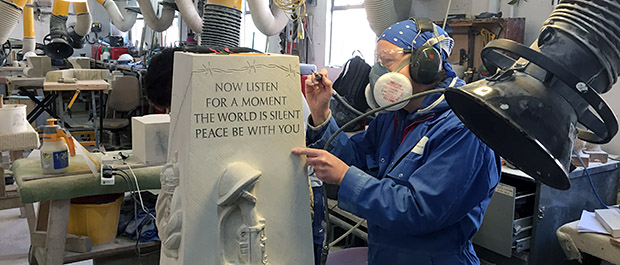Stonehenge

On 13 November a permanent war memorial marking the centenary of the end of World War 1 was unveiled at HMP Erlestoke. The memorial, which was designed by prisoners and carved by Salisbury Cathedral’s stonemasons, sits on a lawn within the visitors’ area of the prison.
The four-foot high memorial, a four-sided pyramid-shape, was dedicated by the Dean of Salisbury, the Very Reverend Nicholas Papadopulos, at a special ceremony that included prisoners, prison and Cathedral staff, and visitors. Dean Nicholas is no stranger to the justice system – he worked as a barrister specialising in criminal law before joining the Church. He’s particularly proud of the role played by the Cathedral’s stonemasons in this project. He said:“It is very easy to regard prisoners as ‘out of sight and out of mind’, and to leave the job of rehabilitation to others. But we all must take responsibility for the society in which we live, and strive to make it better. I am incredibly proud of what has been achieved by the prisoners and our masons working together. We must cherish the hard-won rights and freedoms we enjoy today, inside and outside the prison system, whether working together to create something as meaningful as this memorial, or simply taking time to pause and reflect on the sacrifice of others.”
Rory Stewart, Prisons’ Minister said:“This memorial is a moving tribute to the fallen soldiers who lost their lives bravely serving our country. I am grateful to Salisbury Cathedral for giving offenders from HMP Erlestoke the chance to participate in this hugely worthwhile project. Such opportunities provide a true sense of purpose – helping to support rehabilitation and allowing them to give back to society.”
On each of three sides of the monument the badges of each of the services – Army, Navy and RAF – have been carved, with the simple words ‘land, ‘sea’ and ‘air’ inscribed beneath. A solitary gun with a helmet graces the fourth side beneath the simple quotation: “Now listen For a moment The world is silent Peace be with you.”
The site chosen for the Erlestoke war memorial is a place that all prisoners pass as part of their daily routine, a lasting reminder of the price paid by earlier generations and what can be achieved by working together as a community. Lee Andrews, head mason at Salisbury Cathedral said: “It has been a real privilege for masons to work on this project and collaborate with the prisoners on their design. Between us we have worked hard to make something worthy of those who sacrificed everything. Personally, this project is important to me. As well as working on this memorial, our team also cleaned Salisbury city’s war memorial ready for Remembrance Day. Two of the names on that stone were members of my own family. That brought it all much closer to home.”
The memorial is part of a wider World War 1 centenary initiative within the prison that was conceived by the prisoners themselves and facilitated by Elizabeth Williams, the Prison’s Learning and Skills manager. In addition to designing the monument, the prisoners worked together to create a magazine of poetry and writing about World War 1 and one prisoner drew over a hundred pencil portraits featuring every VC winner during the conflict.
Governor of Erlestoke prison, Tim Knight said: “There’s no doubt that there are challenges managing a prison like this but that shouldn’t overshadow the remarkable work being done by our dedicated and passionate team. We are committed to working with partner agencies like Salisbury Cathedral to provide intervention programmes, and skill and vocational based training and education to make a difference. We hope that by offering prisoners opportunities to participate in projects like this we can assist in their rehabilitation. None of this is a simple fix but our long-term goal.”
Dan Hobbs, Weston College Curriculum Manager for Erlestoke, who assisted on the project said; “This has been a powerful way to raise important issues with prisoners and encourage discussion on important issues in an unforced way. The project leaves behind it a permanent statement, one which will be seen every day by the prisoners as they exercise or move from one part of the prison to another.”